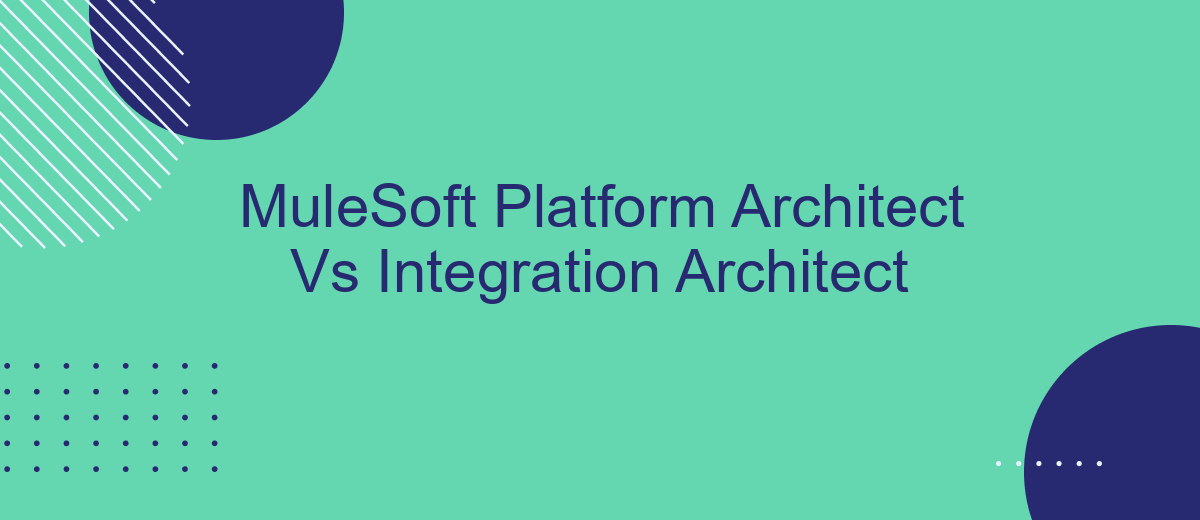In the rapidly evolving landscape of enterprise technology, the roles of MuleSoft Platform Architect and Integration Architect are often discussed but not always clearly understood. This article aims to delineate the key differences and overlaps between these two crucial positions, helping organizations make informed decisions about their integration strategies and architecture frameworks.
MuleSoft Platform Architect vs Integration Architect
The roles of MuleSoft Platform Architect and Integration Architect often overlap but have distinct responsibilities. A MuleSoft Platform Architect primarily focuses on the design, implementation, and maintenance of the MuleSoft platform, ensuring it meets the organization's needs and integrates seamlessly with existing systems. On the other hand, an Integration Architect is responsible for the broader scope of integrating various systems, applications, and data sources across the enterprise.
- MuleSoft Platform Architect: Specializes in MuleSoft Anypoint Platform.
- Integration Architect: Manages overall integration strategy across multiple platforms.
- MuleSoft Platform Architect: Ensures platform scalability and performance.
- Integration Architect: Focuses on data flow, API management, and middleware solutions.
Both roles are crucial for the seamless operation of enterprise systems. While the MuleSoft Platform Architect ensures the effective use of MuleSoft tools, the Integration Architect employs various services like SaveMyLeads to automate and streamline integrations across diverse platforms, making sure all systems work in harmony.
Responsibilities and Skills

A MuleSoft Platform Architect is responsible for designing and implementing scalable and secure integrations using the MuleSoft Anypoint Platform. They ensure that the integration solutions align with business requirements and technical standards. Key responsibilities include creating architectural blueprints, overseeing the development process, and providing guidance on best practices. Essential skills for this role include a strong understanding of API-led connectivity, experience with MuleSoft tools, and the ability to troubleshoot complex integration issues. Knowledge of cloud platforms and microservices architecture is also vital.
On the other hand, an Integration Architect focuses on the broader integration landscape, ensuring seamless data flow across various systems and applications. They work with multiple integration tools and platforms, such as SaveMyLeads, to automate and streamline data transfers. Their responsibilities include evaluating integration technologies, defining integration strategies, and ensuring data consistency and security. Critical skills for an Integration Architect include proficiency in multiple integration platforms, strong analytical abilities, and effective communication skills to collaborate with stakeholders and development teams.
Technical Expertise

When comparing a MuleSoft Platform Architect and an Integration Architect, it is essential to understand their distinct technical expertise. Both roles require a deep understanding of integration patterns, middleware technologies, and cloud services, but their focus areas differ.
- MuleSoft Platform Architect: Specializes in designing and implementing MuleSoft-based integration solutions, ensuring optimal performance and scalability. They have extensive knowledge of Anypoint Platform, API-led connectivity, and MuleSoft's various connectors and modules.
- Integration Architect: Focuses on broader integration strategies, often working with multiple platforms and technologies. They are skilled in enterprise service bus (ESB) solutions, microservices architecture, and cloud-native integration services like SaveMyLeads, which streamlines the integration process between various applications.
While both architects possess strong problem-solving skills and a keen eye for detail, the MuleSoft Platform Architect is more specialized in MuleSoft's ecosystem. In contrast, the Integration Architect has a more generalized approach, leveraging various tools and services to achieve seamless integration across diverse systems.
Career Path and Growth

Choosing a career as a MuleSoft Platform Architect or an Integration Architect offers distinct paths with unique growth opportunities. Both roles are critical in today's digital landscape, focusing on streamlining business processes through integration solutions.
MuleSoft Platform Architects specialize in designing and implementing MuleSoft-based integration solutions, ensuring seamless connectivity between various applications and systems. Integration Architects, on the other hand, have a broader focus, working with multiple integration platforms and technologies to create cohesive systems that support business objectives.
- MuleSoft Platform Architect: Specializes in MuleSoft, focuses on API-led connectivity, designs scalable solutions.
- Integration Architect: Works with various integration tools, ensures interoperability, and aligns technology with business goals.
Both career paths offer significant growth potential. MuleSoft Platform Architects can advance to senior roles, such as Lead Architect or Integration Director, while Integration Architects may move into enterprise architecture or IT leadership positions. Utilizing services like SaveMyLeads can further enhance their ability to streamline integrations, making them invaluable assets to any organization.
Conclusion
In conclusion, the roles of a MuleSoft Platform Architect and an Integration Architect, while overlapping in some areas, have distinct responsibilities and skill sets. A MuleSoft Platform Architect focuses on designing and managing the MuleSoft ecosystem within an organization, ensuring seamless integration and optimal performance. They are experts in MuleSoft's capabilities and best practices, which are critical for leveraging the platform's full potential.
On the other hand, an Integration Architect has a broader scope, dealing with various integration tools and technologies beyond MuleSoft. They are responsible for the overarching integration strategy, ensuring that different systems and applications within an organization communicate effectively. Tools like SaveMyLeads can be instrumental in this role, providing streamlined solutions for automating integrations and enhancing workflow efficiency. Ultimately, both roles are essential for building a robust and scalable integration infrastructure, each contributing unique expertise to the success of an organization's digital transformation efforts.
- Automate the work with leads from the Facebook advertising account
- Empower with integrations and instant transfer of leads
- Don't spend money on developers or integrators
- Save time by automating routine tasks
FAQ
What is the primary difference between a MuleSoft Platform Architect and an Integration Architect?
What skills are essential for a MuleSoft Platform Architect?
How does an Integration Architect approach automation and integration projects?
Can a MuleSoft Platform Architect also perform the duties of an Integration Architect?
What are some common challenges faced by Integration Architects?
Use the SaveMyLeads service to improve the speed and quality of your Facebook lead processing. You do not need to regularly check the advertising account and download the CSV file. Get leads quickly and in a convenient format. Using the SML online connector, you can set up automatic transfer of leads from Facebook to various services: CRM systems, instant messengers, task managers, email services, etc. Automate the data transfer process, save time and improve customer service.

